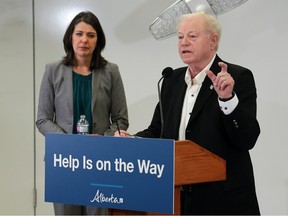“Give people the power, give them the resources, give them the authority to say yes at the local level, and we’re going to get much better service.”

Article content
Alberta Premier Danielle Smith continues to eye re-hauling health care, and offered some details this past week about her push for more regional decision-making and a decentralized system.
“I want managers at the hospital level,” Smith said on her bi-weekly CHED 630 radio show Saturday.
Article content
“Give people the power, give them the resources, give them the authority to say yes at the local level, and we’re going to get much better service,” she said.
Advertisements 2
Article content
According to publicly-posted data from Alberta Health Services (AHS), staffing shortages are helping drive all 33 temporary health care facilities and bed closures currently ailing the province.
Similar arguments have been made for decades, but now Alberta’s single integrated authority has copycats across the country. Operational health care spending in the province is set to cost taxpayers at least $24.5 billion this fiscal year.
Here’s a brief history of nearly 30 years of the tectonic upheavals, regional competition for cash, staff and control, and the still unresolved political tensions over health care in Alberta.
1994
In the midst of a massive deficit-slaying effort and focus on repairing the province’s finances, Progressive Conservative premier Ralph Klein kiboshes more than 200 local hospitals and public health boards, replacing them with 17 health authorities assigned by geography.
Some argue the “local empires” were too costly, and individual requests for resources have become channeled through politicians who have little idea how to prioritize them.
At the same time, critics say the new boundaries appeared to be rooted in the politics of the rural Conservative caucus more so than practicality or logic.
Article content
Advertisements 3
Article content
2004
A decade later, those 17 boards were amalgamated into nine in an effort to make the system more streamlined and accountable.
2008
The PC government under Ed Stelmach moves to dissolve the nine health regions, prompting the creation of a single governing authority at Alberta Health Services (AHS). It comes after the fierce competition for resources among regions led to varying salary and benefit offers, and varying levels of service, depending on where you live.
Health Minister Ron Liepert spearheaded the effort, with the government promising that putting the system under one governing umbrella would save administrative costs that could be channeled into front-line care — although some later claimed the move was about muzzling criticism of the government from staff and regional boards.
Health policy experts at the time warned the might scare medical professionals away from working in the province, while others worried the centralization would create more bureaucracy and less local decision-making, leaving rural areas with little say on how services would be run.
Proponents note the unified authority would have a better ability to share data, plan more efficiently, improve economies of scale, and bring procurement power.
Advertisements 4
Article content
-

Opinion: Decentralizing Alberta Health Services is the wrong move
-

Alberta Premier Danielle Smith blames ‘bad management’ at AHS for lack of health care access
2011
As AHS moves to give top doctors and managers in its five zones around the province the new authority to hire staff and buy equipment, Wildrose leader Danielle Smith argues it needs to put even more power in the hands of doctors and nurses.
“Trying to centrally plan a $10-billion health system just isn’t possible,” Smith says.
By 2012, Smith was still critical of what she called the “unresponsive superboard bureaucracy in Edmonton,” saying it ignored local needs following the closure of a rural long-term care home.
2015
In one high-profile attempt to reintroduce local governance, PC premiere Jim Prentice pitches the idea of setting up eight to 10 new operational health districts. Health Minister Stephen Mandel said they wouldn’t be like the previous nine health regions, which he said were too competitive and fought for each other for resources.
In May, a general election sees Rachel Notley’s NDP sweep to power, and her government soon announces AHS will again be overseen by a board structure that over the previous two years had been replaced by consecutive administrators.
Advertisements 5
Article content
2022
Coming off the heels of the COVID-19 pandemic, the UCP leadership race to replace former premier Jason Kenney in 2022 sparks a fiery debate about the role, structure and management of AHS.
Running a leadership campaign that emphasizes grievances over the handling of COVID-19, Smith argued that AHS was too slow to expand its bed capacity to address front-line needs during the pandemic. When she assumes office, she fires the board of AHS and replaces it with a sole administrator in an effort to fast-track reforms.
2023
As the province prepares for the continued re-haul of health care, Smith tells reporters she will maintain province-wide integration for some things, such as major surgery and heart transplants, but adding more management in local hospitals will increase services, especially in rural areas and small cities.
“It’s not about going back to the way it was before,” Smith says, adding AHS should be focused primarily on acute hospital care.
While Smith has made it clear she opposes vaccine mandates, she says that’s not driving the reform. “It’s all about improving the system.”

Comments
Postmedia is committed to maintaining a lively but civil forum for discussion and encourages all readers to share their views on our articles. Comments may take up to an hour for moderation before appearing on the site. We ask you to keep your comments relevant and respectful. We have enabled email notifications—you will now receive an email if you receive a reply to your comment, there is an update to a comment thread you follow or if a user you follow comments. Visit our Community Guidelines for more information and details on how to adjust your email settings.
Join the Conversation